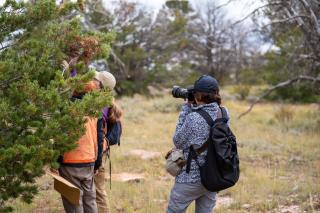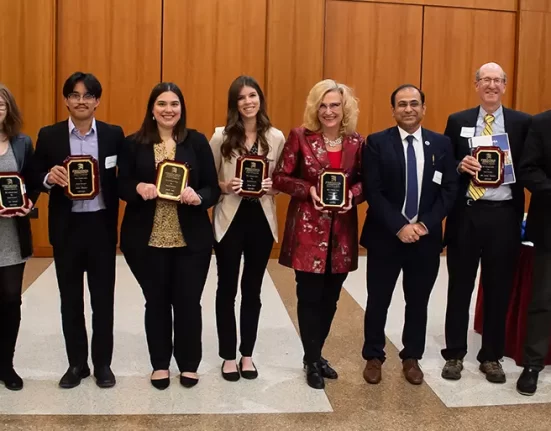COLORADO — Once upon a time, Rocky Mountain Research Station had a vision of actively integrating science and art. In support of this vision, the Science Application and Communications team recently hosted two visiting fine artists: Morvarid “Mo” Kaykha and Alexandre “Alex” Dupeyron, splitting their residence time between Berlin, Germany, and Bordeaux, France.
The visiting artists were able to explore current and historical research in the field at an experimental forest and at multiple labs. The team and artists share a need to encourage a passion for speaking about science through art.
As the pandemic seemed to be easing in January 2022, Mo emailed Jessica Brewen, science delivery specialist with the team, with hopes of visiting the research station that summer. However, the trip was postponed due to ongoing uncertainty around COVID, but planning, partnership building and information sharing proceeded. By spring 2023, when the pandemic was winding down, artists and employees planned days in the field with researchers for October 2023.
Mo and Alex are partners who specialize in creating experimental art series showcased in exhibitions and galleries worldwide. Mo is a visual artist who uses a variety of art mediums in her photography—such as markers, charcoal, soil, bark—to build awareness of ongoing issues that impact humans and the environment. Her work, created from the recent Australian mega-fires, is currently on exhibit in France. Alex uses environmental elements like charcoal to create special pigments for his art. He also captures movement with black and white photography and interpretive performance art. His ongoing series, “Dysnomia,” explores life’s foundational origins.

Rocky Mountain Research Station scientist Anna Schoettle and her team took Mo and Alex to a research site in southern Wyoming, where they learned about her work with limber pine seeds from the local national forests to study genetic resistance to blister rust disease. While in the field, Schoettle explained the complex infection cycle of blister rust and the challenges land managers face in preserving slow-growth forests amid a rapid disease process.
Scientists John Frank, John Korfmacher and George Valentine brought Mo and Alex to the Glacier Lakes Ecosystem Experiments Site in southern Wyoming, where they gave a full tour of the many sites where soils, water, air quality and other research studies have been conducted for decades. The artists also visited the 2020 Cameron Peak Fire area to experience the effects of a more recent fire. Once there, Frank shared with them the collected data from a recently installed monitoring site.
Scientist Jose Negron and his ORISE assistant Olivia Schmit led Mo and Alex on a tour of the entomology and dendrochronology lab in Fort Collins, Colorado, where they learned how researchers are studying the expansion and risk of mountain pine and spruce pine beetles in the western United States and saw wood cookies dated to the 1500s.
Manitou Experimental Forest’s forester and site manager Steve Alton shared historical photos and herbarium samples and gave a tour of the site’s breathtaking historical facilities, originally built by the Civilian Conservation Corps. Mo and Alex also visited areas within Manitou Experimental Forest and Pike National Forest that are experiencing limited reestablishment following the 2002 Hayman Fire.
Mo and Alex continued their journey to the Missoula Fire Lab, where they were given a tour of the facility and went into the field in western Montana with Sharon Hood and Kim Davis’ seasonal teams to gather more data.
Mo and Alex are creating an exhibit currently scheduled for October 2025 in Paris, France. It will highlight the importance of the research being conducted by the station on the impact of issues like wildfires, climate change, insect outbreaks and diseases on humans and the environment.






